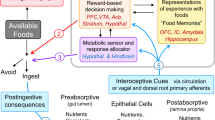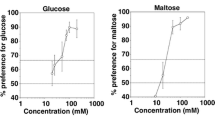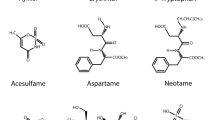Abstract
Dietary intake of l-amino acids impacts on several physiological functions, including the control of gastrointestinal motility, pancreatic secretion, and appetite. However, the biological mechanisms regulating behavioral predilections for certain amino acid types remain poorly understood. We tested the hypothesis that, in mice, the potency with which a given glucogenic amino acid increases glucose utilization reflects its rewarding properties. We have found that: (1) during long-, but not short-, term preference tests, l-alanine and l-serine were preferred over their d-enantiomer counterparts, while no such effect was observed for l-threonine vs. d-threonine; (2) these behavioral patterns were closely associated with the ability of l-amino acids to promote increases in respiratory exchange ratios such that those, and only those, l-amino acids able to promote increases in respiratory exchange ratios were preferred over their d-isomers; (3) these behavioral preferences were independent of gustatory influences, since taste-deficient Trpm5 knockout mice displayed ingestive responses very similar to those of their wild-type counterparts. We conclude that the ability to promote increases in respiratory exchange ratios enhances the reward value of nutritionally relevant amino acids and suggest a mechanistic link between substrate utilization and amino acid preferences.






Similar content being viewed by others
References
Ackroff K, Touzani K, Peets TK, Sclafani A (2001) Flavor preferences conditioned by intragastric fructose and glucose: differences in reinforcement potency. Physiol Behav 72:691–703
Ackroff K, Yiin YM, Sclafani A (2010) Post-oral infusion sites that support glucose-conditioned flavor preferences in rats. Physiol Behav 99:402–411
Bachmanov AA, Beauchamp GK (2008) Amino acid and carbohydrate preferences in C57BL/6ByJ and 129P3/J mice. Physiol Behav 93:37–43
Blouet C, Schwartz GJ (2012) Brainstem nutrient sensing in the nucleus of the solitary tract inhibits feeding. Cell Metab 16(5):579–587
Damak S, Rong M, Yasumatsu K, Kokrashvili Z, Perez CA, Shigemura N, Yoshida R, Mosinger B, Glendinning JI, Ninomiya Y, Margolskee RF (2006) Trpm5 null mice respond to bitter, sweet, and umami compounds. Chem Sens 31:253–264
de Araujo IE, Oliveira-Maia AJ, Sotnikova TD, Gainetdinov RR, Caron MG, Nicolelis MA, Simon SA (2008) Food reward in the absence of taste receptor signaling. Neuron 57(6):930–941
de Araujo IE, Ren X, Ferreira JG (2010) Metabolic sensing in brain dopamine systems. Results Probl Cell Differ 52:69–86
Dolle A (2000) Metabolism of d- and l-[(13)C]alanine in rat liver detected by (1)H and (13)C NMR spectroscopy in vivo and in vitro. NMR Biomed 13(2):72–81
Felig P (1973) The glucose–alanine cycle. Metabolism 22:179–207
Friedman M, Levin CE (2012) Nutritional and medicinal aspects of d-amino acids. Amino Acids 42(5):1553–1582
Fromentin G, Darcel N, Chaumontet C, Marsset-Baglieri A, Nadkarni N, Tome D (2012) Peripheral and central mechanisms involved in the control of food intake by dietary amino acids and proteins. Nutr Res Rev 25(1):29–39
Hao S, Sharp JW, Ross-Inta CM, McDaniel BJ, Anthony TG, Wek RC, Cavener DR, McGrath BC, Rudell JB, Koehnle TJ, Gietzen DW (2005) Uncharged tRNA and sensing of amino acid deficiency in mammalian piriform cortex. Science 307(5716):1776–1778
Hetenyi G Jr, Anderson PJ, Kinson GA (1984) Gluconeogenesis from threonine in normal and diabetic rats. Biochem J 224(2):355–360
Holman GL (1968) Intragastric reinforcement effect. J Comp Physiol Psychol 69:432–441
Jequier E, Acheson K, Schutz Y (1987) Assessment of energy expenditure and fuel utilization in man. Ann Rev Nutr 7:187–208
Lehninger AL, Nelson DL, Cox MM (1993) Principles of Biochemistry. Worth Publisher, New York
Levin BE (2000) Glucose-regulated dopamine release from substantia nigra neurons. Brain Res 874:158–164
Levin BE (2006) Metabolic sensing neurons and the control of energy homeostasis. Physiol Behav 89(4):486–489
Nadkarni GB, Friedmann B, Weinhouse S (1960) Gluconeogenesis from glycine and serine in the rat. J Biol Chem 235:420–425
Pere MC, Gilbert M, Assan R, Battaglia FC (1987) Studies of gut and hepatic metabolism in conscious rabbits. Am J Physiol 252(5 Pt 1):E573–E580
Peters JC, Harper AE (1987) Acute effects of dietary protein on food intake, tissue amino acids, and brain serotonin. Am J Physiol 252(5 Pt 2):R902–R914
Ren X, Ferreira JG, Zhou L, Shammah-Lagnado SJ, Yeckel CW, De Araujo IE (2010) Nutrient selection in the absence of taste receptor signaling. J Neurosci 30:8012–8023
Ritter RC (2004) Gastrointestinal mechanisms of satiation for food. Physiol Behav 81:249–273
Russek M (1970) Demonstration of the influence of an hepatic glucosensitive mechanism on food intake. Physiol Behav 5:1207–1209
Schwartz GJ (2013) Central leucine sensing in the control of energy homeostasis. Endocrinol Metab Clin North Am 42(1):81–87
Sclafani A (2001) Post-ingestive positive controls of ingestive behavior. Appetite 36(1):79–83
Sprinson DB, Chargaff E (1946) The occurrence of hydroxypyruvic acid in biological systems. J Biol Chem 164:411–415
Tome D, Schwarz J, Darcel N, Fromentin G (2009) Protein, amino acids, vagus nerve signaling, and the brain. Am J Clin Nutr 90(3):838S–843S
Tordoff MG (1991) Metabolic bases of learned food preferences. Chemical Senses. Friedman MI, Tordoff MG, Kare MR. New York, Marcel Dekker. 4
Tordoff MG, Friedman MI (1986) Hepatic portal glucose infusions decrease food intake and increase food preference. Am J Physiol 251(1 Pt 2):R192–R196
Treesukosol Y, Smith KR, Spector AC (2011) The functional role of the T1R family of receptors in sweet taste and feeding. Physiol Behav 105(1):14–26
Zhang Y, Hoon MA, Chandrashekar J, Mueller KL, Cook BWD, Zucker CS, Ryba NJ (2003) Coding of sweet, bitter, and umami tastes: different receptor cells sharing similar signaling pathways. Cell 112:293–301
Acknowledgments
R01-DC009997 to IEA is acknowledged.
Conflict of interest
The authors declare no conflicts of interest.
Author information
Authors and Affiliations
Corresponding author
Rights and permissions
About this article
Cite this article
Ren, X., Tellez, L.A. & de Araujo, I.E. Enantiomer-specific selection of amino acids. Amino Acids 45, 1353–1364 (2013). https://doi.org/10.1007/s00726-013-1595-9
Received:
Accepted:
Published:
Issue Date:
DOI: https://doi.org/10.1007/s00726-013-1595-9




